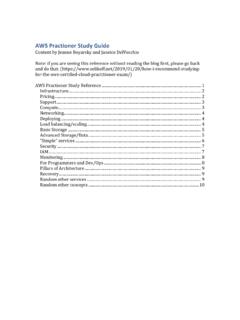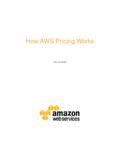Transcription of AWS Cloud Best Practices - d1.awsstatic.com
1 ArchivedArchitecting for the Cloud AWS best Practices October 2018 This asset has been best Practices information, see the AWS Well-Architected Notices This document is provided for informational purposes only. It represents AWS s current product offerings and Practices as of the date of issue of this document, which are subject to change without notice. Customers are responsible for making their own independent assessment of the information in this document and any use of AWS s products or services , each of which is provided as is without warranty of any kind, whether express or implied. This document does not create any warranties, representations, contractual commitments, conditions or assurances from AWS, its affiliates, suppliers or licensors.
2 The responsibilities and liabilities of AWS to its customers are controlled by AWS agreements, and this document is not part of, nor does it modify, any agreement between AWS and its customers. 2018, amazon Web services , Inc. or its affiliates. All rights reserved. Archived Contents Introduction 1 Differences Between Traditional and Cloud Computing Environments 2 IT Assets as Provisioned Resources 2 Global, Available, and Scalable Capacity 2 Higher-Level Managed services 3 Built-in Security 3 Architecting for Cost 3 Operations on AWS 4 Design Principles 5 Scalability 5 Disposable Resources Instead of Fixed Servers 9 Automation 12 Loose Coupling 14 services , Not Servers 18 Databases 20 Managing Increasing Volumes of Data 27 Removing Single Points of Failure 27 Optimize for Cost 33 Caching 36 Security 37 Conclusion 41 Contributors 41 Archived Further Reading 41 Document Revisions 42 Archived Abstract This whitepaper is intended for solutions architects and developers who are building solutions that will be deployed on amazon Web services (AWS).
3 It provides architectural guidance and advice on technical design patterns and how they are applied in the context of Cloud computing. This introduction provides the key concepts and differences when designing solutions on AWS. It includes a discussion on how to take advantage of attributes that are specific to the dynamic nature of Cloud computing, such as elasticity and infrastructure automation. These patterns can provide the context for a more detailed review of choices, operational status, and implementation status as detailed in the AWS Well-Architected Web services Architecting for the Cloud : AWS best Practices Page 1 Introduction Migrating applications to AWS, even without significant changes (an approach known as lift and shift), provides organizations with the benefits of a secure and cost-efficient infrastructure.
4 However, to make the most of the elasticity and agility that are possible with Cloud computing, engineers have to evolve their architectures to take advantage of AWS capabilities. For new applications, Cloud -specific IT architecture patterns can help drive efficiency and scalability. Those new architectures can support anything from real-time analytics of internet-scale data to applications with unpredictable traffic from thousands of connected Internet of Things (IoT) or mobile devices. Whether you are rearchitecting the applications that currently run in your on-premises environment to run on AWS, or designing Cloud -native applications, you must consider the differences between traditional environments and Cloud computing environments.
5 This includes architecture choices, scalability, resource types, automation, as well as flexible components, services , and databases. If you are new to AWS, we recommend that you review the information on the About AWS page to get a basic understanding of AWS ArchivedAmazon Web services Architecting for the Cloud : AWS best Practices Page 2 Differences Between Traditional and Cloud Computing Environments Cloud computing differs from a traditional, on-premises environment in many ways, including flexible, global, and scalable capacity, managed services , built-in security, options for cost optimization, and various operating models. IT Assets as Provisioned Resources In a traditional computing environment, you provision capacity based on an estimate of a theoretical maximum peak.
6 This can result in periods where expensive resources are sitting idle or occasions of insufficient capacity. With Cloud computing, you can access as much or as little capacity as you need and dynamically scale to meet actual demand, while only paying for what you use. On AWS, servers, databases, storage, and higher-level application components can be instantiated within seconds. You can treat these as temporary resources, free from the inflexibility and constraints of a fixed and finite IT infrastructure. This resets the way you approach change management, testing, reliability, and capacity planning. This change in approach encourages experimentation by introducing the ability in processes to fail fast and iterate quickly.
7 Global, Available, and Scalable Capacity Using the global infrastructure of AWS, you can deploy your application to the AWS Region that best meets your requirements ( , proximity to your end users, compliance, data residency constraints, and cost).3 For global applications, you can reduce latency to end users around the world by using the amazon CloudFront content delivery network (CDN). This also makes it much easier to operate production applications and databases across multiple data centers to achieve high availability and fault tolerance. The global infrastructure of AWS and the ability to provision capacity as needed let you think differently about your infrastructure as the demands on your applications and the breadth of your services expand.
8 ArchivedAmazon Web services Architecting for the Cloud : AWS best Practices Page 3 Higher-Level Managed services Apart from the compute resources of amazon Elastic Compute Cloud ( amazon EC2), you also have access to a broad set of storage, database, analytics, application, and deployment services . Because these services are instantly available to developers, they reduce dependency on in-house specialized skills and allow organizations to deliver new solutions faster. AWS services that are managed can lower operational complexity and cost. They are also designed for scalability and high availability, so they can reduce risk for your implementations. Built-in Security In traditional IT environments, infrastructure security auditing can be a periodic and manual process.
9 In contrast, the AWS Cloud provides governance capabilities that enable continuous monitoring of configuration changes to your IT resources. Security at AWS is the highest priority, which means that you benefit from data centers and network architecture that are built to meet the requirements of the most security-sensitive organizations. Since AWS resources are programmable using tools and APIs, you can formalize and embed your security policy within the design of your infrastructure. With the ability to spin up temporary environments, security testing can now become part of your continuous delivery pipeline. Finally, you can leverage a variety of native AWS security and encryption features that can help you achieve higher levels of data protection and compliance.
10 Architecting for Cost Traditional cost management of on-premises solutions is not typically tightly coupled to the provision of services . When you provision a Cloud computing environment, optimizing for cost is a fundamental design tenant for architects. When selecting a solution, you should not only focus on the functional architecture and feature set but on the cost profile of the solutions you select. AWS provides fine-grained billing, which enables you to track the costs associated with all aspects of your solutions. There are a range of services to help you manage budgets, alert you to costs incurred, and to help you optimize resource usage and costs. ArchivedAmazon Web services Architecting for the Cloud : AWS best Practices Page 4 Operations on AWS When operating services on AWS, there are several common categories of operating models: Applications that are migrated, maintain existing traditional operating models, leverage the ability to manage Infrastructure as Code through APIs enabling robust and repeatable build processes, improving reliability.














